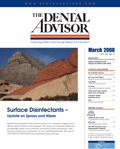Clinical Evaluations
OptiBond All-In-One
Consultants’ Comments
- “Laminated instructions are great.”
- “Very easy technique – use enough to develop a uniformly shiny bonding surface.”
- “Great all-around product.”
- “Doesn’t stick to metal matrix bands.”
- “Bottle may deliver too many drops.”
Description
OptiBond All-In-One is a 7th-generation bonding agent and is indicated for etching, priming, and bonding of enamel and dentin in a single step for both direct and indirect procedures. The manufacturer recommends the use of Maxcem or NX3 with indirect restorations whenever light accessibility is limited or absent. Application requires two, 20-second surface scrubs followed by 5 seconds of a gentle air stream before a 10-second light cure. OptiBond All-In-One is available in a Bottle Kit with one 5-ml bottle of adhesive; three, 0.18-ml unit-doses of adhesive; 50 applicator brushes and accessories. The unit-dose is also available in 50-count and 100-count packages. OptiBond All-In-One was evaluated by 27 consultants in over 1200 restorative procedures. This product received a 96% clinical rating.
Product Features
Consultants rated the ease of dispensing, application, and versatility of OptiBond All-In-One highly. The unit-dose package, viscosity and surface wetting also were rated very high. The time for a double application of bonding agent seemed long to some consultants, whereas others felt the process was faster since etching was not needed. There were no reported cases of post-operative tooth sensitivity. The solvent in OptiBond All-In-One includes acetone which brings some odor to the product. Eighty-one percent of consultants found OptiBond All-In-One equivalent to or better than their current bonding agent, 63% would switch, and 85% would recommend it to a colleague.
Clinical Tips
- Bevel enamel cavosurfaces of direct preparations whenever possible for improved etching efficacy and bond strength.
- Scrub the tooth surface when applying the bonding agent.
- Use light air pressure to disperse the agent.
- Remove pooled solution from preparation before curing – excess material could prevent complete seating of indirect restorations.



